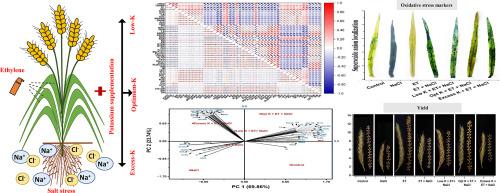盐胁迫下,乙烯-钾相互作用维持离子平衡、叶绿素生物合成和源库代谢,维持小麦生长和产量响应
IF 6.8
Q1 PLANT SCIENCES
引用次数: 0
摘要
由于盐对农业土壤的影响,作物产量显著下降。为了满足饥饿需求,需要有重大的解决方案来加快农业生产,即使是在受盐影响的土壤中。由于盐胁迫降低了钾(K+)的吸收,补充K+营养可能是一种耐受机制。本研究探讨了不同K+水平(低、最佳和过量)以及胁迫激素乙烯对盐胁迫下植物反应的调节作用。结果表明,乙烯和K+的相互作用显著改变了盐诱导的抑制作用,通过改善K+滞留、叶绿素生物合成和源库代谢来保护生长和产量性状。此外,乙烯和K+改善了关键途径,如防御机制、一氧化氮(NO)生物合成以及次生代谢物(木质素、纤维素、类黄酮和苯酚),以克服盐诱导的逆境。乙烯与不同K+水平之间的相互作用所造成的影响描述了盐诱导逆境的可变缓解。综上所述,乙烯和最佳K+处理对盐抑制反应的抑制效果最好。添加去甲二烯(NBD,乙烯作用抑制剂)进一步证实了乙烯和不同K+浓度之间的相互作用在盐胁迫响应中的作用。本研究可为品种发展规划提供重要策略,以对抗盐抑制限制,并为确保作物安全铺平道路。本文章由计算机程序翻译,如有差异,请以英文原文为准。

Ethylene–potassium interactions safeguard ionic balance, chlorophyll biosynthesis, and source–sink metabolism to sustain wheat growth and yield responses under salt stress
Significant reduction in crop yields has been caused due to salt-impacted agricultural soils. In order to meet hunger requirements, significant solutions are required for speeding up agricultural production even in salt-impacted soils. As salt stress reduces the uptake of potassium (K+), replenishing the K+ nutrition may serve as a tolerance mechanism. The present study investigated the different K+ levels (low, optimum, and excess) along with a stress hormone, ethylene in modulating plant responses under salt stress. The results demonstrated that the interplay of ethylene and K+ significantly altered salt induced inhibition through improved K+retention, chlorophyll biosynthesis, and source-sink metabolism to protect growth and yield traits. Additionally, ethylene and K+ improved key pathways such as defense machinery, nitric oxide (NO) biosynthesis along with secondary metabolites (lignin, cellulose, flavonoid and phenol) to overcome salt-induced adversities. The impacts posed by the interplay between ethylene and different K+ levels depicted a variable mitigation of salt induced adversities. Conclusively, ethylene and optimum K+ treatment best excruciated the salt-inhibited responses. Supplementation of norbonadiene (NBD, ethylene action inhibitor) further confirmed the role of interplay between ethylene and differential K+ concentrations in mediating the salt stress responses. The present study pose as a significant strategy towards cultivar development programs to counter salt-inhibited constraints and paves way to ensure crop security.
求助全文
通过发布文献求助,成功后即可免费获取论文全文。
去求助
来源期刊

Plant Stress
PLANT SCIENCES-
CiteScore
5.20
自引率
8.00%
发文量
76
审稿时长
63 days
期刊介绍:
The journal Plant Stress deals with plant (or other photoautotrophs, such as algae, cyanobacteria and lichens) responses to abiotic and biotic stress factors that can result in limited growth and productivity. Such responses can be analyzed and described at a physiological, biochemical and molecular level. Experimental approaches/technologies aiming to improve growth and productivity with a potential for downstream validation under stress conditions will also be considered. Both fundamental and applied research manuscripts are welcome, provided that clear mechanistic hypotheses are made and descriptive approaches are avoided. In addition, high-quality review articles will also be considered, provided they follow a critical approach and stimulate thought for future research avenues.
Plant Stress welcomes high-quality manuscripts related (but not limited) to interactions between plants and:
Lack of water (drought) and excess (flooding),
Salinity stress,
Elevated temperature and/or low temperature (chilling and freezing),
Hypoxia and/or anoxia,
Mineral nutrient excess and/or deficiency,
Heavy metals and/or metalloids,
Plant priming (chemical, biological, physiological, nanomaterial, biostimulant) approaches for improved stress protection,
Viral, phytoplasma, bacterial and fungal plant-pathogen interactions.
The journal welcomes basic and applied research articles, as well as review articles and short communications. All submitted manuscripts will be subject to a thorough peer-reviewing process.
 求助内容:
求助内容: 应助结果提醒方式:
应助结果提醒方式:


